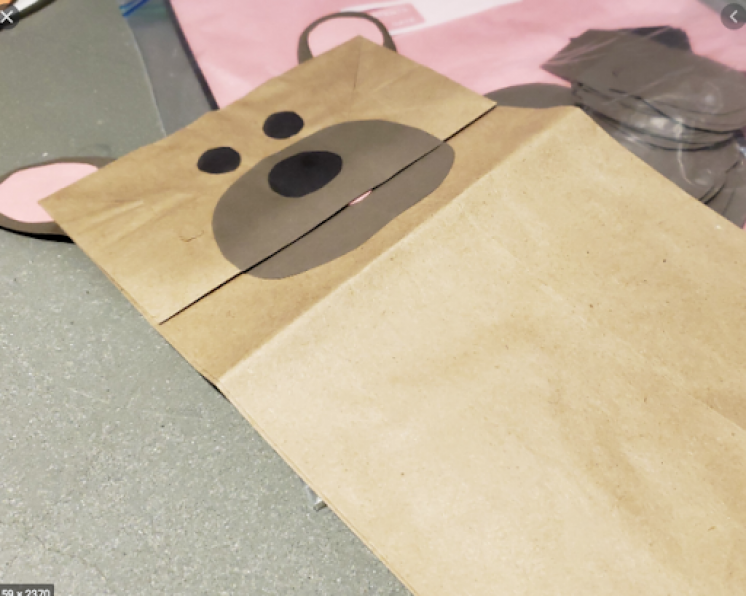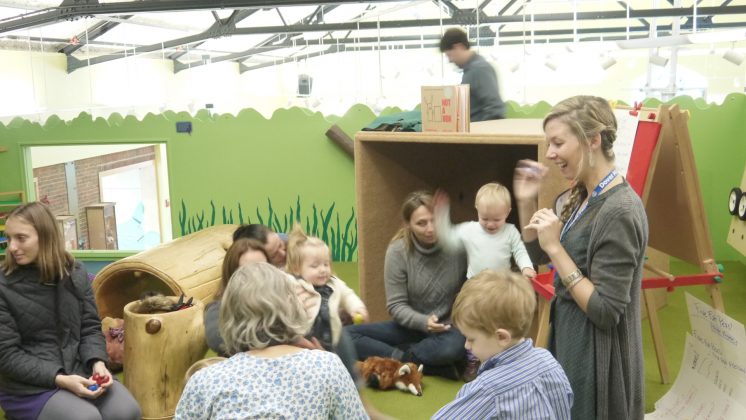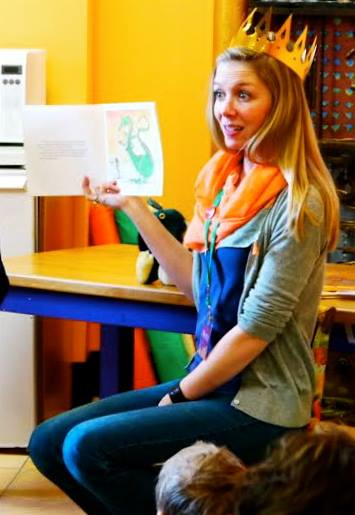The Museum Blog
Category: Storytime
Books Alive: Bruce the Bear puppet
Make a Bruce the Bear bag puppet!
Bruce the Bear was our special guest for Books Alive & Story Explorers this month. We read “Mother Bruce” and enjoyed the story of Bruce mothering a group of baby goslings!
There are lots of other Bruce the Bear books by local Maine author Ryan T. Higgins -you can check them out at your local library and learn about Bruce’s other adventures!
To make your own Bruce the Bear puppet to bring on adventures, follow these instructions:
Materials Needed:
- Small paper bag
- Two small paper circles (for his ears!)
- One paper triangle or circle (for his nose!)
- Glue or tape
- Markers or crayons
Instructions:
- Place your paper bag on your work surface so that the square bottom is facing you and turned upwards (This will be the head/mouth of your puppet!)
- Use your glue or tape to attach the ear and nose pieces
- Decorate your puppet with markers or crayons!

Children's Books for Grief
By Neva Cole, CMNH Communications Director
When I first started working at the Children's Museum of New Hampshire, I knew my mother had only months to live. She had been diagnosed with cancer and we were in the process of saying goodbye. My daughter was four at the time. My mother, ever the educator, was the first to suggest that we look into some picture books that might help her grandkids understand what was about to happen. So, on top of starting a new job, parenting a four year old, being there for my family, and processing my own grief, I now had to find picture books to somehow help me try to explain death to my daughter.
But Mom was right. She always is. I'm glad I took the time to find some of those books, because talking about death with anyone is not easy, but with kids...it seems even more complicated. Depending on their age, they don't necessarily have the vocabulary to understand what dying really means. And unless you've spent a lot of time pondering the process yourself, you might not be well equipped to explain it to them. My Mom would speak to her in her own religious terms, introducing the idea of Heaven, but with every new word comes a whole different set of questions.
But in the end, those questions are what it's all about. Starting a dialogue with your kids about what death means to you, and encouraging them to ask those hard questions, helps prepare them for something that no one in this world escapes from. We will all be dealing with it, sooner or later, wether we have time to prepare for it or not. We were fortunate to have time.
Four years later, we still talk about Nana with the same language we learned from those picture books. We even have one of those audio picture books that Nana recorded so we could always hear her voice telling us a story. Recently I met Linda Dinndorf who is a Training and Education Coordinator for a NH non-profit called Friends of Aine. Aine was established to provide bereavement support services to grieving children and families. This organization was borne out of the tragic loss of Aine Marie Phillips (pronounced Ahnya) at age 8, and the recognition that bereavement services for Aine's surviving 5-year-old sister Bella, were sadly scarce. I told Linda about my Mom's passing and how it was a struggle to find resources as simple as picture books that would help my daughter process her grief, and she instantly said, "Oh, we have a great library of picture books for all ages! We'd be happy to share some info with you!"
So thank you Linda for this wonderful list, which can also be found here on their website: https://www.friendsofaine.com/...
On this list of resources, I see some of the books that I used, like The Invisible String, by Patrice Karst, and Badger's Parting Gifts by Susan Varley, both gentle, loving stories about how the people we love may leave this world, but their memories and influence remain constant. I hope this list helps you when you need it most.
Sometimes I Feel Like a Storm Cloud – by Leslie Evans
I Will Always Love You – by Melissa Lyons
The Memory Box: A Book About Grief – by Joanna Rowland
A Child’s View of Grief – by Alan Wolefeit
Badger’s Parting Gifts – by Susan Varley
Help Me Say Goodbye – by Janis Silverman
How It Feels When a Parent Dies – by Jill Krementz
In Mommy’s Garden – by Neyal J. Ammary
Lifetimes: The Beautiful Way to Explain Death to Children – by Bryan Mellonie
Saying Goodbye When You Don’t Want To – by Martha Bolton
Sesame Street – When Families Grieve Kit – by Sesame Workshop
Someone I Loved Died – by Christine Harder Tanguald
Tear Soup: A Recipe for Healing After Loss – by Pat Schwiebert
The Fall of Freddie the Leaf – by Leo Buscaglia
The Invisible String – by Patrice Karst
The Mountains of Tibet – by Mordicai Gerstein
The Tenth Good Thing About Barney – by Judith Voirst
Turned Upside Down – by Karen Keesler
Waterbugs and Dragonflies – by Doris Stickney
What On Earth Do You Do When Someone Dies? – by Trevor Romain
When Dinosaurs Die – by Laurie Krasny Brown
Wherever You Are: My Love Will Find You – by Nancy Tillman
Learn more about Friends of Aine here https://www.friendsofaine.com/
Compassion and Diversity
This summer we had a wonderful art exhibit on view in Gallery 6 here at CMNH featuring the art of Richard Haynes, a Portsmouth, NH African American artist and the Associate Director of Admissions for Diversity at UNH. Haynes' vibrant drawings ask us to use the universal language of "Love" to see how we can all rewrite a history that has not been fair to everyone.
To close the exhibit, we're doing a day of art making on Saturday, August 24 from 10am-2pm here at the museum. The day will offer lots of opportunities to make art with fine art materials, go on a scavenger hunt, a chance to contribute to a community art project, AND...listen to stories!
And because we can only do so many storytimes in one day, we thought we'd share our favorite picture books that highlight the very important themes of unity, compassion and diversity, here on our blog. We hope you check them out and share with your kids.
Peace
by Wendy Anderson Halperin
For ages 4-8
This poetic and soothing book ponders the eternal question asked in the Tao Te Ching: How can we bring peace to the world? Using lavishly detailed drawings, each with a storyline of its own, the illustrator shares her artistic rendition of the path to true inner peace.
Strictly No Elephants
Written by Lisa Mantchev and Illustrated by Taeeun Yoo
For ages 4-8
Today is "Pet Club Day." There will be cats and dogs and fish but strictly no elephants are allowed. The Pet Club doesn't understand that pets come in all shapes and sizes, just like friends. Now it is time for a boy and his tiny pet elephant to show them what it means to be a true friend.
Talk Peace
Written by Sam Williams and Illustrated by Mique Moriuchi
For ages 4-8
"On the street,
when you meet,
when you eat, when you play.
Talk peace."
Kids and animals from around the world invite readers to dance and play and make the sounds of peace in this tribute to harmony.
We March
by Shane W. Evans
For ages 4-8
On August 28, 1963, a remarkable event took place - more than 250,000 people gather in our nation's capital to participate in the March on Washington for Jobs and freedom. The march began at the Washington Monument and eded with a rally at the Lincoln Memorial, where Martin Luther King Jr. delivered his historic "I Have a Dream" speech, advocating racial harmony. This book combines Evans simple yet compelling illustrations and words to show the thrill of the day.
Barefoot: Escape on the Underground Railroad
Written by Pamela Duncan Edwards and Illustrated by Henry Cole
For ages 4-8
A heron, a squirrel, a mouse, a deer, and a frog all witness a pair of bare feet running frantically through the woods. The feet belong to a runaway slave trying to escape his pursuers, whom the animals recognize as the Heavy Boots. Following the animals' lead, the Barefoot is able to escape and survive. He listens for the croaking of a frog to find fresh water and observes the nibbling of a mouse to find berries to eat. Eventually he comes upon a house in the woods - but is it really a stop on the Underground Railroad? Firefly light reveals a quilt hanging in front of the house - a signal of welcome.
When Harriet Met Sojourner
Written by Catherine Clinton and Illustrated by Shane W. Evans
For ages 4-8
Two women with similar backgrounds. Both slaves; both fiercely independent. Both great in different ways. Harriet Tubman: brave pioneer who led her fellow slaves to freedom, larger than life...yearning to be free. Sojourner Truth: strong woman who spoke up for African American rights, tall as a tree...yearning to be free.
One day in 1864, the lives of these two women came together. When Harriet met Sojourner is a portrait of these two remarkable women, from their inauspicious beginnings to their pivotal roles in the battle for America's future.
Child of the Civil Rights Movement
by Paula Young Shelton and Raul Colon
for ages 4-8
What was it like growing up in the Deep South when Jim Crow laws were everywhere? How did it feel to sit down to dinner with grown-ups who planned protests between bites of Mama's creamy macaroni and cheese? And imagine walking right beside Uncle Martin and Aunt Coretta in that historic march from Selma to Montgomery - until your legs were so tired that you had to ride on your father's back. Paula Young Shelton, a daughter of civil rights leader Andrew Young, and Raul Colon take readers on a vivid trip back to Paula's childhood in an extraordinary family - the family of the American civil rights movement!
Dog's Colorful Day: Our Family Literacy Month Book!

Why “Dog’s Colorful Day”?
As the Literacy Coordinator here at The Children’s Museum I had the exciting task of picking the book we would be giving away to visitors as part of our Family Literacy Month celebration.
This might sound like a simple task. I adore picture books and use them as much as possible in all the programs I do here at the museum. I go to the library to pick out a few books for a specific class and always come back with about 12 more than originally planned. I can’t help myself!
However, this book buying was different. I wanted to choose a book that had great illustrations and a fun story--- I wanted the book to be entertaining for adults as well as children, I wanted it to prompt fun conversations among families and become a favorite to be enjoyed over and over again. I wanted it to be a book that could be appreciated by a grandparent, a teenage babysitter, an 18 month old or a nine year old—or even better—all of those people together!
Needless to say, it took me a very (very) long time to select a book.
The book I ended up picking is “Dog’s Colorful Day” by Emma Dodd.
This is a story of a busy little dog that goes on a colorful adventure and ends up getting into all kinds of messy trouble—teaching colors and numbers along the way. School Library Journal calls it “A multifaceted concept book and a charming story to boot!” I couldn’t agree more.
Here’s why I think “Dog’s Colorful Day” is a perfect fit for Family Literacy Month—and how you might like to use it with your family:
For reading with Babies:
- The book has clear illustrations that are easy for baby’s eyes to see and understand—there are many familiar shapes that appear in the book (shoe, ball, table, clouds). These are great to point out to baby--it will help them understand the world around them. Point these items out in the book while you read and then find real life examples.
- There are wonderful onomatopoeic words (Splat! Splish! Squash!) These playful words will resonate in baby’s ears and help them learn the sounds of our language.
- It’s a lovely and fun introduction to colors and numbers.
For reading with Toddlers & Preschoolers:
- This book is perfect for reading with the toddler & preschool age group—be sure to ask lots and lots of questions while you read—“What do you see on this page that Dog might get into? What color spot do you think he will get? Can you help me count Dog’s colorful spots?”
- As you read the book—point out the different colors of spots that Dog has—ask your toddler or preschooler if they can remember how Dog got each of his colorful spots. This activity will reinforce narrative skills—one of the most important pre-reading skills!
Reading with Older Children:
- This book has many familiar words that children starting to read will recognize. The pictures also lend themselves well as clues to help figure out what the words on the page say.
- Use it as a math activity! Ask your older child “If I wiped off Dog’s pink spot and blue spot—how many spots would he have left?”
- Do an art activity when you finish reading the book—have your child draw a picture of dog and then add all of his colorful spots.
I hope you enjoy “Dog’s Colorful Day” as much as I do. It’s a splendid book to read together as a family and has lots and lots of potential for literacy activities at home.
If you do enjoy “Dog’s Colorful Day”---Emma Dodd has written two more books about the adventures of Dog—“Dog’s ABC’s” and “Dog’s Noisy Day”. What kind of trouble will Dog get into next? Sounds to me like a good reason to pile into the car and head to the library!
We would like to give an extra special "Thank You!" to our Family Literacy Month sponsors for making these book giveaways possible:



Happy Reading!
-Meredith
meredith@childrens-museum.org
Shaky Eggs

by Meredith Lamothe, Early Childhood and Literacy Coordinator
We were making shaky eggs the entire first week of our Toddlerfest celebration. Shaky eggs or egg maracas are a great first percussion instrument for little ones and a fun way for them to feel included in making music as well as get a good introduction to rhythm, which is an important early literacy skill!
There are lots of songs that can be used with shaky eggs—actually, you can shake along to most any song you like or listen to---but there are a handful of songs that I use regularly in Baby Storytime here at the museum that highlight shaky eggs and are a lot of fun.
Here’s a few you can try at home!
Counting Shakes: (Tune: "If You’re Happy and You Know It")
If you’re happy and you know it shake your egg—one time!
If you’re happy and you know it shake your egg—two times!
If you’re happy and you know it and you really want to show it, if you’re happy and you know it shake your egg—three times!
(Keep going for however long the focus lasts!)
Shake, Clap, Tap! (Tune: "If You’re Happy and You Know It")
If you’re happy and you know it give a shake
If you’re happy and you know it give a shake! (etc)
If you’re happy and you know it give a clap!
If you’re happy and you know it give a clap (etc)
If you’re happy and you know it give a tap (tap your egg on a surface or part of your body)
If you’re happy and you know it give a tap (etc)
If you’re happy and you know it give a shake! And a clap! And a tap!
Shake Your Shaker! (Tune: "London Bridges")
Shake your shaker way up high, way up high, way up high
Shake your shaker way up high
Shake your Shaker
Shake your shaker…
Way down low
To the left
To the right
On your foot!
On your head
Really fast
Really slow
Etc!
That’s just a sampling of the egg shaker songs we do during Baby Storytime—stop by on Wednesdays at 9:30am in Primary Place to see the other ways we use them.
Shakers can also be used as an early reading and literacy tool. Bump them along the pages of a book to point out the different words, sound out familiar words and names using the eggs to accentuate the different syllables, or read a book that lends itself to music (Pet the Cat anyone?) and have your shaky eggs ready for the grooviest parts of the book!
How will you use your egg shaker at home?! Let us know!
Storytime: SNOW

by Meredith Lamothe
Hi there! I am the Lead Educator at The Children’s Museum of New Hampshire and also the host of Baby Storytime. I have a Bachelors Degree in Theatre from The University of Southern Maine and a Masters of Library and Information Science with a focus in Children’s Services from Simmons College.
I’m passionate about early literacy and excited to share information with you about our weekly Baby Storytime stories and activities. Join us for the next Baby Storytime which meets every Wednesday in the Museum's Primary Place exhibit at 9:30am.
SNOW
Our theme today is perfect for the kind of weather we're having: SNOW!
Let's start with a rhyme about snowflakes:
Snow, Snow is falling down
Falling down onto the ground
it’s falling over here
And it’s falling over there
It’s falling so much that it’s everywhere!
Now, what could we do in all that snow? I know! We could ride in our little red sleds!
This one is to the tune of “Bumping up and down in my little red wagon”
Slippin’ and Slidin’ in my little red sled
Slippin’ and Slidin’ in my little red sled
Slippin’ and Slidin’ in my little red sled
Won’t you be my darling?
It is snowy and the sled string’s broken
It is snowy and the sled string’s broken
It is snowy and the sled string’s broken
Won’t you be my darling?
It’s easy to fix with a big strong knot
Easy to fix with a big strong knot
Easy to fix with a big strong knot
Won’t you be my darling?
Slippin’ and Slidin’ in my little red sled
Slippin’ and Slidin’ in my little red sled
Slippin’ and Slidin’ in my little red sled
Won’t you be my darling?
And since we sang about slippin’ and slidin’ in sleds, I have to include my favorite bounce song “The Royal Duke of York” who likes marching armies up and down hills! I bet they wish they had sleds…:)
Now let's do another rhyme about snow. It's called “Five Little Snowmen” and we do this one counting on our fingers:
Five little snowmen standing in a row
Each one has a hat and a big red bow
Out came the sun and it shone all day
And one little snowman melted away!
Four little snowmen…
Three little snowmen…
Two little snowmen…
One little snowman standing in the row
He had a hat and a big red bow
Out came the sun and it shone all day
And that little snowman melted away!
Literacy Tip
Our literacy tip is about talking! Talking about books, making predictions and asking questions helps children understand things when they’re learning to read. Comprehension is an important pre-reading and reading skill. Some kids will learn to read and be able to fly through books, but at the end when asked “So, who was the good guy in that story?” They may have no idea, because although they’re reading – the comprehension is missing – and if that’s missing, those kids won’t stay motivated to read.
Asking babies a question or two about a book before you begin to read helps you and them get into that habit. Talking about books with your child gets them ready to read!
Our last song is about what to wear in the snow! It's called “Boots, Parka, Scarf and Hat” and is to the tune of “Head, Shoulders, Knees and Toes”–you can point to where these items of clothing go while singing this song!
Boots, Parka, Scarf and Hat
Scarf and Hat
Boots, Parka, Scarf and Hat
Scarf and Hat
Boots and Parka and Scaaaaaarf and Haaaaaat
Boots, Parka, Scarf and Hat
Scarf and Hat!
Storytime: Nursery Rhymes
 By Meredith Lamothe
By Meredith Lamothe
Hi there! I am the Lead Educator at The Children’s Museum of New Hampshire and also the host of Baby Storytime. I have a Bachelors Degree in Theatre from The University of Southern Maine and a Masters of Library and Information Science with a focus in Children’s Services from Simmons College.
I’m passionate about early literacy and excited to share information with you about our weekly Baby Storytime stories and activities. Join us for the next Baby Storytime which meets every Wednesday in the Museum's Primary Place exhibit at 9:45am.
NURSERY RHYMES
We started with "Open Them, Shut Them," which we do every week. I thought I’d post the words here for anyone who doesn’t know this wonderful song/finger play.
Open them, shut them
Open them, shut them
Give a little clap clap clap!
Open them, shut them
Open them, shut them
Lay them in your lap
Creep them, creep them
Creep them, creep them
Right up to your chin chin chin!
Open up your little mouth…But do not let them in!
I love that one!
The reason we do this rhyme every week and why I will commonly use the same rhymes/songs/finger plays is because repetition is so important for babies and for early literacy! Even though we, as adults, may get tired of hearing the same rhyme/song over and over again–babies enjoy hearing the same things over and over again. They gain familiarity with the actions and words and are able to play along. They’re also learning vocabulary from those songs and rhymes and each time we sing the song or say the rhyme it is a little different and babies will always be getting something different out of our repetitions!
LITERACY TIP
Our literacy tip today is about rhythm in rhymes or songs. Babies are learning to speak our language just as we would have to learn to speak a new language–to many of them our words sound like big long strings of sounds with no clear words or phrases. When we bounce babies on our laps while singing a song or saying a phrase or when we clap out words during a rhyme (this was tricky!) we’re helping to get them ready to read by knowing that a number of different words make up a sentence which makes up a story or song.
The rhyme that we clapped to was “To Market”
Here are the words:
To market, to market to buy a fat pig
Home again, home again, jiggety-jig
To market, to market to buy a fat hog,
Home again, home again, jiggety-jog
This is another fun rhyme about Rain!
Rain on the green grass,
And rain on the tree;
Rain on the house top,
But not on me!
Storytime: The Royal Duke of York
By Meredith Lamothe
Hi there! I am the Lead Educator at The Children’s Museum of New Hampshire and also the host of Baby Storytime. I have a Bachelors Degree in Theatre from The University of Southern Maine and a Masters of Library and Information Science with a focus in Children’s Services from Simmons College.
I’m passionate about early literacy and excited to share information with you about our weekly Baby Storytime stories and activities. Join us for the next Baby Storytime which meets every Wednesday in the Museum's Primary Place exhibit at 9:45am.
 NURSERY RHYMES
NURSERY RHYMES
I had a request for the lyrics to “The Royal Duke of York” (otherwise known as "The Grand Old Duke of York") as well as the motions – so here they are!
BOUNCE: The Royal Duke of York (This is sung to the tune of “A Hunting We Will Go”)
Bounce babies on lap. When you say “up,” lift them up, when you say “down,” sit them back down in your lap.
Oh, the Royal Duke of York,
He had ten thousand men,
He marched them up the mountain top
and marched them down again.
Oh, when you’re up, you’re up.
And when you’re down, you’re down.
And when you’re only halfway up,
You’re neither up nor down.
He rolled them to the left.
He rolled them to the right.
He rolled them backwards down the hill
Oh what a silly sight!
LITERACY TIP
Singing and saying Nursery Rhymes is a great way to get babies ready to read! Children who know nursery rhymes by heart tend to have an easier time learning to read because playing with the rhymes (whether saying them or singing them) helps them to understand how words come together and go apart!
The Mother Goose Story book we used today is one of my favorites and is illustrated by Rosemary Wells, here’s a link to the Amazon listing: http://www.amazon.com/My-Very-First-Mother-Goose/dp/1564026205
